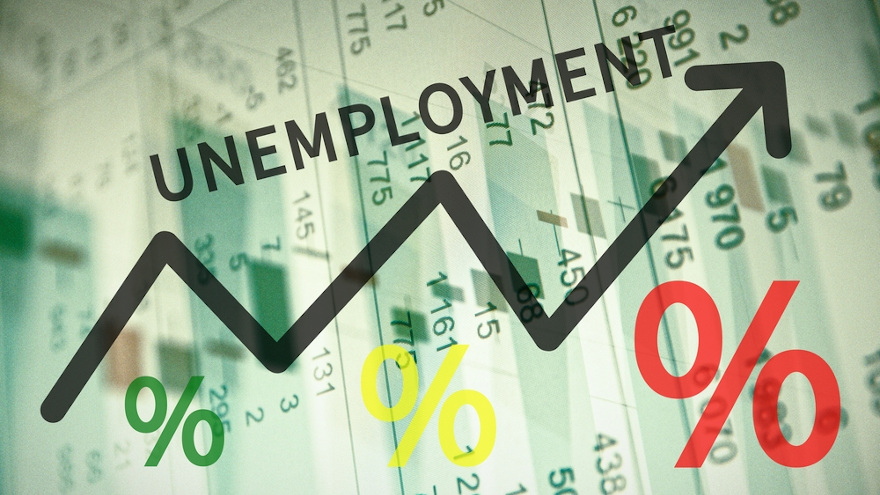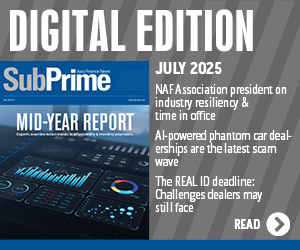As average auto APRs adjust, jobless claims spike past 10 million

Image by g0d4ather / Shutterstock.com
As the auto-finance industry adjusted annual percentage rates (APR) on both used- and new-vehicle paper originated in March, the possibility your portfolio contains contract holders who no longer have their job jumped significantly, based on the newest data released by the U.S Department of Labor on Thursday morning.
Labor Department officials said that during the week ending March 28, the advance figure for seasonally adjusted initial claims was 6,648,000, an increase of 3,341,000 from the previous week’s revised level. The figure represents the highest level of seasonally adjusted initial claims in the history of the seasonally adjusted series.
Officials added the previous week’s level was revised up by 24,000 from 3,283,000 to 3,307,000 stemming from the coronavirus pandemic.
“Combined with last week’s initial claims, 10 million Americans have applied for unemployment benefits in two weeks. That is over 6 percent of the labor force. It will be critical to provide assistance not only to those workers, but to their employers, in order to ensure strong labor demand once the worst of the health crisis is past,” said Curt Long, chief economist at the National Association of Federally-Insured Credit Unions (NAFCU).
Secretary of Labor Eugene Scalia also reacted to the record volume of unemployment insurance claims, emphasizing other programs rolled out by the federal government.
“Similar to last week’s unemployment claims numbers, today’s report reflects the sacrifices American workers are making for their families, neighbors and country in order to ‘slow the spread,’” Scalia said. “The administration continues to act quickly to address this impact on American workers. That includes a rule the Labor Department adopted yesterday to implement the paid leave provisions of the Families First Coronavirus Response Act, and the department’s work with the states to make available the enhanced unemployment benefits provided in the CARES Act, which the president signed last week. That legislation also contains significant incentives for businesses to retain workers and continue paying them, which will put businesses and workers in a better position to resume work and re-boot the economy once the virus is contained.”
Containing the virus likely is a goal for all segments of the economy, not just the auto-finance sector. For an industry working to still retail and finance vehicles during the crisis, James Houston emphasized this factor.
“Any program that assures consumers the affordability of the vehicle they are purchasing during uncertain times and gives after-sale support for those who financed their vehicle helps to generate consumer confidence,” said Houston, who is managing director of consumer lending and automotive finance at J.D. Power.
March auto finance data
Edmunds reported the average interest rate for new-vehicle financing rose slightly in March on a sequential basis, but the metric dipped year-over-year.
The annual percentage rate (APR) on new financed vehicles averaged 5.8% in March, compared to 5.6% in February. However, last March, the average stood at 6.4%.
On the used-vehicle side, the average APR on paper originated in March also climbed on a sequential basis, ticking up to 9.1% from 8.3%. Last March, the used average came in at 9.5%.
With an array of automakers and their captives pushing special programs during the crisis, Edmunds data revealed that the share of new-model sales with zero percent finance deals saw a slight uptick in March, constituting 4.7% of new-vehicle purchases compared to 3.6% in February.
“Automakers reacted quickly to the coronavirus crisis with attractive incentive offers and payment programs, but these unfortunately appeared to fall on deaf ears,” Edmunds executive director of insights Jessica Caldwell said.
“Consumers were understandably distracted by the rapidly changing news cycle and changes to everyday life created by shelter-in-place orders, and March sales took a blow,” Caldwell continued.
Edmunds pointed out that amount contracts with APRs of 10% or higher saw a lift in March, constituting 12.8% of sales compared to 10.7% in February. Term lengths also increased in March, surpassing 70 months for the first time on record.
According to Edmunds, the share of borrowers who had a 73- to 84-month term rose to 35.3% in March, compared to 32.8% in February.
“Vehicle purchases made in March — particularly the second half — were likely need-based,” Caldwell said. “These shoppers might not have necessarily qualified for zero percent finance offers but still needed a car in spite of everything else going on in the world.”
More on prices and incentives
ALG, a subsidiary of TrueCar, projected average transaction prices (ATP) on new vehicles to be up 3.2% or $1,108 from a year ago and up 0.6% or $208 from February.
“Before we get too excited that we are not seeing a decline in average transaction prices, along with the steep sales decline, we must bear in mind that the coronavirus pandemic did not truly affect vehicle sales until the middle of March,” said Eric Lyman, chief industry analyst for ALG, a subsidiary of TrueCar.
“Historically, there’s been a strong correlation between consumer confidence and average transaction price,” Lyman continued. “We’re now seeing one of the largest one-month declines in consumer confidence in nearly 50 years. April will provide a much clearer picture of the full impact caused from the Coronavirus.”
ALG projects that U.S. revenue from new-vehicle sales will reach more than $33.5 billion for March, down 40% (based on a non-adjusted daily selling rate) from a year ago and down 31% from last month.
“Given our 41% forecast decline in new-vehicle sales this month, we expect revenue from new-vehicle sales to drop by 40% from a year ago,” said Nick Woolard, director of OEM and affinity partner analytics for TrueCar. “Social distancing mandates will continue for another month, so we expect the sales and revenue declines to continue through April.”
Lyman elaborated on those future sales expectations.
“We continue to emphasize that the decline will translate to deferred sales, not lost sales,” Lyman said. “Vehicles are extensions of the home. When we come out of this period of heightened health and safety awareness from the pandemic, we expect that personal vehicles may even become an alternative for a subset of consumers who previously opted for public transportation.”
Brad Korner, general manager of Cox Automotive Rates and Incentives, dissected the latest moves by automakers and captives. Korner explained that March offers appear to be holding in place for early April for two key reasons:
1. Korner noted OEMs are evaluating consumer activity to offers like 0% interest, waiving first three payments and deferred payment starts
2. He mentioned automakers also are evaluating consumer demand for offers that may include home delivery, electronic contracting and virtual delivery tools.
“With the market and economy impacted by COVID-19, OEMs are changing incentive offers and cadences,” Korner said. “Traditionally, new incentive programs are released the first few days of the month and are held in place for the most part through the month-end. However, with COVID-19 ravaging the economy, roughly two-thirds of brands reacted with new offers midway through March in an effort to slow rapidly falling sales.
“It is likely we will see weekly OEM incentive offers remain fluid as a reflection of shopper activity and feedback,” he added.
New-Vehicle Finance Data
|
|
March 2020 |
March 2019 |
March 2015 |
|
Term |
70.6 |
69.6 |
67.6 |
|
Monthly Payment |
$573 |
$553 |
$489 |
|
Amount Financed |
$34,052 |
$31,962 |
$28,592 |
|
APR |
5.8% |
6.4% |
4.8% |
|
Down Payment |
$4,008 |
$4,217 |
$3,508 |
Used-Vehicle Finance Data
|
|
March 2020 |
March 2019 |
March 2015 |
|
Term |
67.8 |
67.6 |
66.1 |
|
Monthly Payment |
$412 |
$406 |
$377 |
|
Amount Financed |
$22,155 |
$21,524 |
$20,347 |
|
APR |
9.1% |
9.5% |
8.2% |
|
Down Payment |
$2,643 |
$2,715 |
$2,410 |
Source: Edmunds


